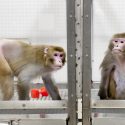Elderly mice yield clues to the process of growing old
Delving deep into the molecular subtleties of a strain of mice engineered to age rapidly, scientists have found that an accumulation of genetic mutations prompts a cascade of programmed cell death that seems to underpin the aging process.
Writing today (July 15, 2005) in the journal Science, a team of scientists led by UW–Madison geneticist Tomas A. Prolla describes a series of experiments in mutant and normal mice that peel away some of the root secrets of mammalian aging.
Growing old, according to the new study, occurs, in part, as mutations build up in the DNA of energy-generating mitochondria, triggering the death of critical cells that lead to such things as hair and weight loss, hearing and vision impairment, loss of muscle mass, weakened bones and fewer circulating red blood cells. Mitochondria are structures within cells that provide energy for cells to move, divide, contract and secrete products vital for the health of organisms.
“We think that the key to what is happening in aging is that as (genetic) mutations or DNA damage accumulates, critical cells die,” says Prolla. “These experiments favor a major role for programmed cell death in aging.”
If true, the new insights may one day lead to opportunities to stave off old age through drugs that could prevent the gathering of genetic defects in mitochondrial DNA, genetic material that resides outside of the nucleus of a cell and that helps power critical cell processes.
Such insight could also lead to strategies to restore some functions such as hearing by protecting mitochondrial DNA from naturally occurring mutations.
Using mice genetically altered to have a deficiency in a protein that proofreads mitochondrial DNA and thus accumulate genetic mutations at a higher rate than unaltered mice, the group led by Prolla found evidence that programmed cell death, known as apoptosis, was greatly accelerated. The altered mice exhibited obvious hallmarks of aging – including graying, hair loss and atrophied muscle and bone – at a pace much faster than the typical laboratory mouse.
“It’s like a broken spellchecker,” says Prolla. “By introducing a malfunction in the (genetic) proofreading domain, these mutations accumulate much more rapidly.”
The new work lends support to one of the two leading theories of how animals, including humans, grow old and die. It supports the theory that apoptosis or programmed cell death underpins aging. A competing theory holds that oxidative stress – the body’s reaction to oxygen and the production of reactive, cell-damaging molecules known as free radicals – is responsible for the aging process.
According to the new Science report, markers of oxidative stress did not parallel the accumulation of mitochondrial genetic mutations. Instead, the group found evidence that indicated accelerated cell death, especially in tissues characterized by rapid turnover of cells, occurred as mutations mounted in the mitochondrial DNA.
“We found no evidence of oxidative stress,” Prolla explains. In fact, the team noted less oxidative stress in some tissues – the liver, for example – which suggests that accumulated genetic mutations in mitochondria slow metabolism. In turn, that change prompts cells to produce fewer of the reactive free radical molecules.
The symptoms of aging become pronounced with the loss of some critical cells, notably adult stem cells from some tissues and that are essential for replacing cells that die. “If these stem cells are lost, tissue structure and the ability of tissue to regenerate are impaired,” Prolla explains. “We have observed that in tissues like bone marrow, intestine and hair follicles.”
The altered mice used in the study were created by manipulating mouse embryonic stem cells to produce mice with the defective DNA proofreading protein. The mice develop normally, but age rapidly and develop such things as age related heart dysfunction, hair loss, loss of immune cells, anemia, and loss of male germ cells that lead to reduced sperm production and infertility.
Intriguingly, the mice develop symptoms of old age, notably gray hair and hair loss, more commonly seen in humans than mice.
Prolla suggests that new studies of mice engineered to have fewer than normal mitochondrial DNA defects or improved mitochondrial function may pave the way for strategies to retard aging. “The idea would be to reduce the level of cell death and improve function. If that pans out, then we can begin to think about pharmaceutical interventions to retard aging by preserving mitochondrial function.”
The new study was supported by grants from the National Institutes of Health.

